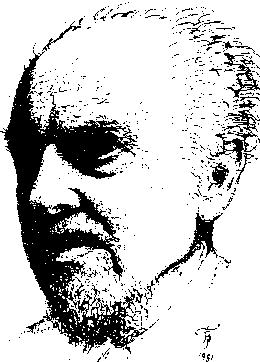|
Click here for centenary events
Tom was the unwanted child of elderly parents whose strict Victorian lifestyle and lack of sympathy with his artistic ambitions caused Tom to be withdrawn from school at 14 and apprenticed to an engineer in the workshop of Hick Hargreaves. His seven year 'serfdom' however, was not wasted. Many of his designs for transmission machinery for the cotton industry survive as do some exquisite Indian ink and water-colour paintings of railway engines. In his spare hours, his interest in music burgeoned. He studied piano, harmony and also played the cello. At 16 he made his first attempts at composition although he did not go to an orchestral or chamber music concert until he was in his early twenties. At this time he also wrote quantities of blank verse after the style of Shakespeare's sonnets. He continued to write poetry throughout his life. Whenever possible he escaped to the Pennine moors to sketch nature scenes - especially trees.
At age 21, Tom had saved enough to pay for a year's study at the Royal Manchester College of Music where his teachers were Thomas Keighley, Frank Merrick and Carl Fuchs. He always maintained that he was self taught as a composer - though he received informal help and encouragement from Eric Fogg of the BBC. A sixpenny purchase of '221 Scottish Songs, to which he improvised his own piano accompaniments, and the Russian folk songs he learned from his future wife, Alice (who, though Lancastrian born, grew up in Russia) were to prove a strong influence on his compositional stlye.
The death of his father in 1928 and the ill health of his mother with her doctrine of the 'Godliness of misery' blighted his life, preventing his marriage to Alice until 1934 and causing him to train as a teacher of art and cabinet work at Bolton College of Art where he won a scholarship in 1931. He was a brilliant student and much of his work from this period is now in the Pitfield Archive at the Royal Northern College of Music.
At about this time his first music was published by Augener and Oxford University Press, notably his best known work 'Prelude, minuet and Reel' for piano and a Piano Trio. He also received commissions from Hubert Foss for cover designs for various publications including Britten's Simple Symphony which, due to Britten's move to Boosey & Hawkes, was never used. In all Tom had his music published by more than 50 publishers
After various teaching jobs undertaken to supplement his erratic income from composition, Tom took up an offer from The Royal Manchester college of Music in 1947 where he taught until his retirement in 1973. His pupils included the composers, David Ellis, John Golland, John McCabe, John Ogden and Ronald Stevenson.
Around this time he was commissioned to write 100 short pieces for the Royal Academy of Dance's new ballet examinations. This collection, which brought his name to a wide audience, was frequently quarried for material of later works, notably the Flute Sonatina written for Gareth Morris. (Available from Piper Publications).
The chamber music from his middle period is substantial yet beguiling. There is a formally ingenious Violin Sonata (no. 1) in which the finale, a set of cyclical variations, recapitulates in reverse order the themes from the whole work. In the two movement Oboe Sonata in A minor, the second movement is a set of variations acting as slow movement, scherzo and finale combined. There is also an energetic Trio for flute, oboe and piano. (The two latter both published by Piper).
Tom Pitfields's three volume autobiography ' No Song, No Supper' (1986), 'A Song After Supper' (1990) and A cotton town boyhood' (1993) is available from Printwise Productions.
Despite stylistic traits which could descent to mannerism, including pianistic figurations using black and white note chords alternated between hands, and an inordinate fondness for 7/8 metre, Tom Pitfield had the gift for memorable tunes, often couched in somewhat French-sounding harmonic and decorative idiom. He admired Vaughan Williams, Grainger and Delius and their influence can be felt in his works. Composing for unusual instruments was a Pitfield speciality - he wrote solo works for accordion, clarsach, xylophone and harmonica.
A CD of Tom Pitfield's music is published by the Royal Northern College of Music, 124, Oxford Rd., Manchester M13 9RD price £8 (Promotions Department (0)161 273 6283). Works include: Violin Sonata no.1, Oboe Sonata in A minor, Prelude, minuet & Reel, Three Nautical Sketches and a selection of songs.
The orchestral version of the Three Nautical Sketches and the Recorder Concerto are available on CD from Olympia 0CD667 (www.olympia-cd.com) performed by John Turner and the Royal Ballet Sinfonia conducted by Gavin Sutherland.
The above is freely adapted from an article written by John Turner published in The Musical Times (Spring 2000 issue) with his permission.
A Flourish of Carols SSA(A)
Concertino Academica
Variegations for Piano & Orchestra see also Alice Pitfield Collection
Piper Publications Catalogue
Piper Publications Home Page
Piper Composers
|
